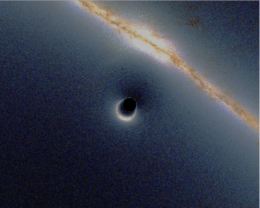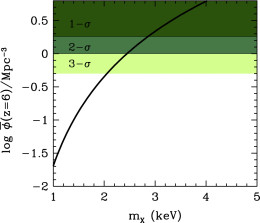Could the dark matter in our universe be “warm” instead of “cold”? Recent observations have placed new constraints on the warm dark matter model.
What’s the Deal with Cold/Warm/Hot Dark Matter?

An example of cold dark matter: MACHOs, massive objects like black holes that are hiding in the halo of our galaxy. [Alain r]
Neutrinos are an example of hot dark matter: very light particles with free streaming lengths much longer than the size of a typical galaxy. Cold dark matter could consist of objects like black holes or brown dwarfs, or particles like WIMPs — all of which are very heavy and therefore have free streaming lengths much shorter than the size of a galaxy.
Warm dark matter is what’s in between: middle-mass particles with free streaming lengths roughly the size of a galaxy. There aren’t any known particles that fit this description, but there are theorized particles such as sterile neutrinos or gravitinos that do.

Cumulative mass functions at z = 6 for different values of the warm dark matter particle mass mX. The shaded boxs on the left correspond to the observed number density of faint galaxies within different confidence levels. [Menci et al. 2016]
Smoothing Out the Universe
The widely favored model is lambda-CDM, in which cold dark matter makes up the missing matter in our universe. This model nicely explains much of what we observe, but it still has a few problems. The biggest issue with lambda-CDM is that it predicts that there should be many more small, dwarf galaxies than we observe.
While this could just mean that we haven’t yet managed to see all the existing, faint dwarf galaxies, we should also consider alternative models — the warm dark matter model chief among them.
In the early universe, small density perturbations on sub-galactic scales produce dwarf galaxies in the lambda-CDM model. But in the warm dark matter model, the longer free streaming length of the dark matter particles smooth out some of those small perturbations. This results in the formation of fewer dwarf galaxies — which fits better with our current observations.
Limits on Warm Dark Matter
So how can we test this alternative model? The maximum number density of dark-matter halos predicted by the warm dark matter model at a given redshift depends on the mass of the candidate dark matter particle: a larger particle mass means that more halos form. We therefore can set lower limits on the mass of dark matter particles in a two-step process:
- Calculate the maximum number density of dark matter halos predicted by models, and
- Compare this to the measured abundance of the faintest galaxies at a given redshift.

Another way of looking at it: for different values of the dark matter particle mass mX, this shows the maximum number density of dark matter halos predicted at z = 6. The shaded areas represent the observed number density of faint galaxies at different confidence levels. [Menci et al. 2016]
Menci and collaborators find that these new observations constrain the particle masses to be above 2.9 keV at the 1σ confidence level. These constitute the tightest constraints on the mass of candidate warm dark matter particles derived to date, and they even allow us to rule out some production mechanisms for theorized particles.
Extending this analysis to other clusters with deep observations will only improve the constraints, bringing us ever closer to understanding what dark matter is made of.
Citation
N. Menci et al 2016 ApJ 825 L1. doi:10.3847/2041-8205/825/1/L1

1 Comment
Pingback: AAS article on cold versus warm DM